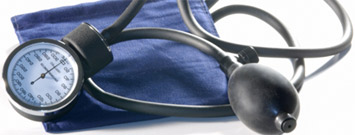Getting Blood Pressure Under Control: High Blood Pressure is Out of Control for Too Many Americans
 Almost 67 million Americans have high blood pressure, and more than half of them do not have it under control. High blood pressure is a major risk factor for heart disease and stroke, two of the leading causes of death in the United States. Learn what you can do to get your blood pressure under control.
Almost 67 million Americans have high blood pressure, and more than half of them do not have it under control. High blood pressure is a major risk factor for heart disease and stroke, two of the leading causes of death in the United States. Learn what you can do to get your blood pressure under control.
High blood pressure, also called hypertension, means having a systolic blood pressure number (top number) of 140 mmHg or higher and a diastolic blood pressure (bottom number) of 90 mmHg or greater. Although medication is often prescribed to help control high blood pressure, 1 in 4 Americans with uncontrolled high blood pressure do not take their medication regularly. This month's Vital Signs issues a challenge for health care providers and patients to achieve better control of this condition.
Key Findings from the Report
- High blood pressure contributes to nearly 1,000 deaths per day and accounts for nearly $131 billion in direct healthcare costs each year.
- Most people know they have high blood pressure, but it's not under control. As many as 16 million report being on medication and seeing a doctor at least twice a year.
- There are many opportunities to gain control of this serious public health problem, and using a team based approach can help.
A Team-Based Approach
These key findings suggest that controlling high blood pressure may benefit from a team-based approach between health care systems, health care providers (those who see and treat patients), and patients to work together to treat high blood pressure.
"We have to roll up our sleeves and make blood pressure control a priority every day, with every patient, at every doctor's visit," said CDC Director Thomas R. Frieden, M.D., M.P.H. "With increased focus and collaboration among patients, health care providers and health care systems, we can help 10 million Americans' blood pressure come into control in the next five years."
High blood pressure control improves when:
Health care systems use electronic health records, encourage the use of 90-day refills and consider having low, or no, co-pays.
Health care providers, i.e. doctors, nurses, pharmacists, etc. track their patients' blood pressure, prescribe once a day medications and give clear instructions on taking blood pressure medications.
Patients take the initiative to monitor their blood pressure levels between medical visits, take medications as prescribed by their doctor and notify their doctor of any side effects, and make lifestyle changes such as eating a low-sodium diet, exercising, and stopping smoking.
What Can Be Done
The federal government is:
- Joining the private sector in leading the national Million Hearts™ initiative to prevent 1 million heart attacks and strokes by 2017.
- Working with pharmacists on activities to provide education and counseling to patients with high blood pressure.
- Focusing on the importance of high blood pressure as a Leading Health Indicator.
- Measuring progress against the specific objectives in Healthy People 2020.
Health systems can:
- Start having doctors, nurses, and others who treat patients review records, looking for patients who need more attention to their high blood pressure.
- Create system-wide targets using Healthy People 2020 objectives for all patients to achieve blood pressure control.
- Update staff monthly on progress and give feedback on success measures.
- Make it easier for patients to stay on medicines:
- Consider 90- day refills for prescriptions
- No or lower co-pays for medicines
Health care providers can:
- Flag and track patients with uncontrolled high blood pressure and those at risk. Report progress on patients using National Quality Forum (NQF) 0018.
- Counsel patients to take their medicine, make lifestyle changes, and follow their progress.
- Regularly evaluate blood pressure medicines to determine whether these need to be changed.
- Address every blood pressure reading that is high by talking with the patient about taking prescribed medicines, adjusting current medicines and/or encouraging lifestyle changes. Consider once-a-day doses of medicines when possible.
Everyone can:
- Take medicine you have been prescribed each day and follow the directions on the bottle. If your blood pressure is still not under control or if you have side effects, talk to your doctor, nurse, or pharmacist about possibly changing your medicine.
- Work to maintain a healthy weight and meet the Physical Activity Guidelines for Americans.
- Follow a heart healthy eating plan, which foods lower in sodium.
- Get help to stop smoking. If you don't smoke, don't start.
- Measure and write down your blood pressure readings between doctor's visits. This can be done at home, at a grocery store, or the pharmacy.
- Keep your doctor, nurse, pharmacist or other health care provider informed of your blood pressure readings that you take at home.
More Information
- CDC Vital Signs
- Division for Heart Disease and Stroke Prevention
- Read the CDC Vital Signs Morbidity and Mortality Weekly Report (MMWR) on high blood pressure
- Listen to the CDC Vital Signs Podcast or PSA on high blood pressure and cholesterol control.
- Learn More About High Blood Pressure and Cholesterol [PDF-190K].
- CDC VitalSigns: Getting Blood Pressure Under Control [VIDEO - 01:57 minutes]
Get email updates
To receive email updates about this page, enter your email address:
Contact Us:
- Centers for Disease Control and Prevention
1600 Clifton Rd
Atlanta, GA 30333 - 800-CDC-INFO
(800-232-4636)
TTY: (888) 232-6348 - cdcinfo@cdc.gov



